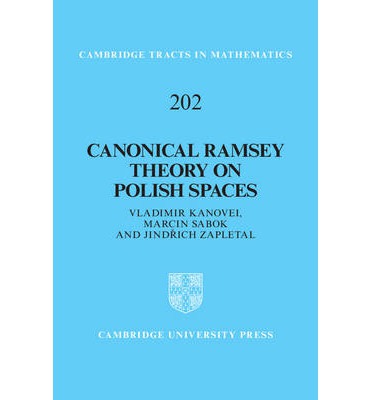
Canonical Ramsey Theory on Polish Spaces (Cambridge Tracts in Mathematics)
[Book Description]
This book lays the foundations for an exciting new area of research in descriptive set theory. It develops a robust connection between two active topics: forcing and analytic equivalence relations. This in turn allows the authors to develop a generalization of classical Ramsey theory. Given an analytic equivalence relation on a Polish space, can one find a large subset of the space on which it has a simple form? The book provides many positive and negative general answers to this question. The proofs feature proper forcing and Gandy-Harrington forcing, as well as partition arguments. The results include strong canonization theorems for many classes of equivalence relations and sigma-ideals, as well as ergodicity results in cases where canonization theorems are impossible to achieve. Ideal for graduate students and researchers in set theory, the book provides a useful springboard for further research.
[Table of Contents]
Preface vii
1 Introduction 1 (13)
1.1 Motivation 1 (2)
1.2 Basic concepts 3 (4)
1.3 Outline of results 7 (3)
1.4 Navigation 10 (2)
1.5 Notation 12 (2)
2 Background facts 14 (31)
2.1 Descriptive set theory 14 (2)
2.2 Invariant descriptive set theory 16 (2)
2.3 Forcing 18 (5)
2.4 Absoluteness and interpretations 23 (8)
2.5 Generic ultrapowers 31 (2)
2.6 Idealized forcing 33 (9)
2.7 Concentration of measure 42 (1)
2.8 Katetov order and coding functions 42 (3)
3 Analytic equivalence relations and models 45 (17)
of set theory
3.1 The model V[x]E 45 (9)
3.2 The model V [[x]]E 54 (2)
3.3 The poset P1E 56 (6)
4 Classes of equivalence relations 62 (18)
4.1 Smooth equivalence relations 62 (1)
4.2 Countable equivalence relations 63 (5)
4.3 Equivalence relations classifiable by 68 (8)
countable structures
4.4 Hypersmooth equivalence relations 76 (2)
4.5 Analytic vs. Borel equivalence 78 (2)
relations
5 Games and the Silver property 80 (20)
5.1 Integer games connected with 80 (6)
σ-ideals
5.2 Determinacy conclusions 86 (4)
5.3 The selection property 90 (7)
5.4 A Silver-type dichotomy for a 97 (3)
σ-ideal
6 The game ideals 100(47)
6.1 σ-ideals σ-generated by 100(20)
closed sets
6.2 Porosity ideals 120(14)
6.3 Laver forcing 134(2)
6.4 Fat tree forcings 136(3)
6.5 The Lebesgue null ideal 139(8)
7 Benchmark equivalence relations 147(40)
7.1 The E0 ideal 147(3)
7.2 The E1 ideal 150(22)
7.3 The E2 ideal 172(15)
8 Ramsey-type ideals 187(31)
8.1 Halpern-Lauchli cubes 187(3)
8.2 Silver cubes 190(6)
8.3 Ellentuck cubes 196(6)
8.4 Milliken cubes 202(5)
8.5 Matet cubes 207(11)
9 Product-type ideals 218(26)
9.1 Finite products and the covering 218(4)
property
9.2 Finite products of the E0 ideal 222(10)
9.3 Infinite products of perfect sets 232(8)
9.4 Products of superperfect sets 240(4)
10 The countable support iteration ideals 244(20)
10.1 Iteration preliminaries 245(2)
10.2 The weak Sacks property 247(1)
10.3 A game reformulation 248(7)
10.4 The canonization result 255(5)
10.5 The iteration of Sacks forcing 260(1)
10.6 Anticanonization results 261(3)
References 264(4)
Index 268

 新书报道
新书报道